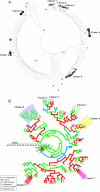Patterns and characteristics of hepatitis C transmission clusters among HIV-positive and HIV-negative individuals in the Australian trial in acute hepatitis C
- PMID: 21282185
- PMCID: PMC3106259
- DOI: 10.1093/cid/ciq200
Patterns and characteristics of hepatitis C transmission clusters among HIV-positive and HIV-negative individuals in the Australian trial in acute hepatitis C
Abstract
Background: Injecting drug users remain the population at greatest risk of acquiring hepatitis C virus (HCV) infection, although a recent increase in cases of sexually transmitted HCV infection has been observed among human immunodeficiency virus (HIV)-infected individuals. The extent to which these separate epidemics overlap is unknown.
Methods: The Australian Trial in Acute Hepatitis C (ATAHC) enrolled 163 individuals (29% of whom were HIV infected) with recent HCV infection. E1/HVR1 sequences were used to construct phylogenetic trees demonstrating monophyletic clusters or pairs, and viral epidemic history and phylogeography were assessed using molecular clock analysis. Individual clusters were characterized by clinical and demographic characteristics.
Results: Transmission through injection drug use occurred for 73% of subjects, with sexual transmission occurring for 18% (92% of whom were HIV infected). Among 112 individuals with available E1/HVR1 sequences, 23 (20%) were infected with a strain of HCV identical to that of another subject, comprising 4 homologous clusters and 3 monophyletic pairs, the majority of which (78%) were HIV infected. Clusters contained individuals with both injection drug use-related and sex-related acquisition, and in all clusters (except for 1 female HIV-uninfected pair), individuals identified as men who have sex with men, irrespective of HIV status.
Conclusions: This large unique study of HIV-infected and HIV-uninfected individuals with recently acquired HCV infection demonstrates that clustering is common in the HIV-infected population and that it occurred almost invariably among men who have sex with men, irrespective of the actual mode of acquisition. These findings suggest the coexistence of both injection drug use and sexual risk behaviors for individuals in the same social networks and have implications for the development of public health messages. Clinical trial registration. NCT00192569.
Figures

Similar articles
-
A latent class approach to identify multi-risk profiles associated with phylogenetic clustering of recent hepatitis C virus infection in Australia and New Zealand from 2004 to 2015.J Int AIDS Soc. 2019 Feb;22(2):e25222. doi: 10.1002/jia2.25222. J Int AIDS Soc. 2019. PMID: 30746864 Free PMC article.
-
Hepatitis C infection among intravenous drug users attending therapy programs in Cyprus.J Med Virol. 2010 Feb;82(2):263-70. doi: 10.1002/jmv.21690. J Med Virol. 2010. PMID: 20029809
-
Low prevalence of hepatitis C co-infection in recently HIV-infected minority men who have sex with men in Los Angeles: a cross-sectional study.BMC Infect Dis. 2015 Nov 20;15:538. doi: 10.1186/s12879-015-1279-z. BMC Infect Dis. 2015. PMID: 26590028 Free PMC article.
-
Residual risk of infection with blood-borne viruses in potential organ donors at increased risk of infection: systematic review and meta-analysis.Med J Aust. 2019 Nov;211(9):414-420. doi: 10.5694/mja2.50315. Epub 2019 Sep 5. Med J Aust. 2019. PMID: 31489635
-
Acute hepatitis C in HIV-infected men who have sex with men: an emerging sexually transmitted infection.AIDS. 2010 Jul 31;24(12):1799-812. doi: 10.1097/QAD.0b013e32833c11a5. AIDS. 2010. PMID: 20601854 Review.
Cited by
-
Transmission of Hepatitis C Virus among Prisoners, Australia, 2005-2012.Emerg Infect Dis. 2015 May;21(5):765-74. doi: 10.3201/eid2105.141832. Emerg Infect Dis. 2015. PMID: 25897788 Free PMC article.
-
Prevalence of hepatitis C in a Swiss sample of men who have sex with men: whom to screen for HCV infection?BMC Public Health. 2014 Jan 6;14:3. doi: 10.1186/1471-2458-14-3. BMC Public Health. 2014. PMID: 24393532 Free PMC article.
-
Cytokine profile and viral diversity in the early seronegative stage of community-acquired hepatitis C virus (HCV) infection.Sci Rep. 2023 Nov 16;13(1):20045. doi: 10.1038/s41598-023-47335-x. Sci Rep. 2023. PMID: 37973814 Free PMC article.
-
Drug use and phylogenetic clustering of hepatitis C virus infection among people who use drugs in Vancouver, Canada: A latent class analysis approach.J Viral Hepat. 2018 Jan;25(1):28-36. doi: 10.1111/jvh.12758. Epub 2017 Sep 4. J Viral Hepat. 2018. PMID: 28719060 Free PMC article.
-
Review on the molecular epidemiology of sexually acquired hepatitis C virus infection in the Asia-Pacific region.J Int AIDS Soc. 2020 Sep;23(9):e25618. doi: 10.1002/jia2.25618. J Int AIDS Soc. 2020. PMID: 32969173 Free PMC article. Review.
References
-
- Maher L, Li J, Jalaludin B, Chant KG, Kaldor JM. High hepatitis C incidence in new injecting drug users: a policy failure? Aust N Z J Public Health. 2007;31:30–5. - PubMed
-
- Robotin MC, Copland J, Tallis G, et al. Surveillance for newly acquired hepatitis C in Australia. J Gastroenterol Hepatol. 2004;19:283–8. - PubMed
-
- Cochrane A, Searle B, Hardie A, et al. A genetic analysis of hepatitis C virus transmission between injection drug users. J Infect Dis. 2002;186:1212–1. - PubMed

